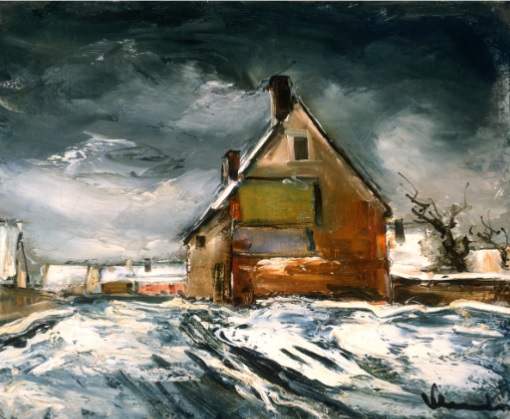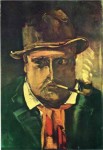
Maurice Vlaminck
French, 1876-1958
Snowy Landscape (Paysage de Neige), 1930s
oil on canvas
15 x 18 1/8 in.
SBMA, Gift of Anonymous Donor
1997.102

Maurice Vlaminck, Self Portrait with Pipe, n.d.
COMMENTS
French painter, printmaker, draughtsman and writer. His nature, character, tastes and way of life were in perfect harmony with the freedom, daring and violence of his painting. He was brought up in a musical environment: his father, of Flemish origin, was a violin teacher and his mother, from Lorraine, was a piano teacher. He studied music himself to quite a high standard and later played the double-bass (and sometimes the bass drum, a source of considerable pleasure) in his regimental band. His family had come to live at Le Vésinet near Paris, and he spent his childhood both there and later at Chatou on the Seine. From 1892 he began to take an interest in painting, though he worked as a mechanic and became a racing cyclist.
After his first marriage (to Suzanne Berly) Vlaminck gave up cycling and returned to music. He gave violin lessons and played the violin in popular orchestras and café-concerts in Paris. He also made his début as a journalist in the late 19th century and wrote articles for anarchist papers such as "Le Libertaire". From 1900 to 1901, when he was called up for military service, he shared a studio at Chatou with André Derain. Self-taught, Vlaminck was still in search of a style in his first canvases, but his violence of expression was already apparent in works such as the "Bar Counter" (1900; Avignon, Mus. Calvet) or the portrait of "Père Bouju" (1900; Paris, Pompidou). Freeing colour from its purely descriptive function, Vlaminck used broad, turbulent brushstrokes in a kind of proto-Expressionism but very quickly graduated to the Fauvist style that he practised from 1904 to 1907.
Vlaminck’s first exhibited works were in a group show at the Berthe Weill gallery, Paris, in 1904, followed by four canvases at the 1905 Salon des Indépendants and eight paintings in the Salon d’Automne that same year. It was in the last exhibition that he and other artists, including Matisse and Derain, were derisively labelled ‘Fauves’ (‘wild beasts’; see Fauvism ). Similarities in the work produced during these years by Derain and Vlaminck in particular were not coincidental, since they had shared the same studio and often painted scenes depicting their immediate surroundings, as in Vlaminck’s "Houses at Chatou" (c. 1905–6; Chicago, IL, A. Inst.) and "The River Seine at Chatou" (1906; New York, Met.). Vlaminck’s boldest paintings of the period include the "Portrait of Derain" (1905; Mexico City, J. Gelman priv. col., see 1976 exh. cat., p. 48), in which the face is vermilion, the "Restaurant de la Machine at Bougival" (c. 1905; Paris, Mus. d’Orsay), the "Bateaux-lavoirs" (1905; Paris, priv. col., see Muller, p. 72) and the "Red Trees" (1906; Paris, Pompidou).
The impact on Vlaminck of the van Gogh exhibition of 1901 at the Bernheim-Jeune gallery, Paris, where he was introduced to Matisse by Derain, was succeeded in 1907 by that of the Cézanne retrospective at the Salon d’Automne. In response to these stimuli, Vlaminck’s exuberant use of colour gave way to a concern with structure, and at the same time he developed a dramatic view of landscape that was to remain a hallmark of his work. Although his Cézanne-influenced period continued only to c. 1910, it included a series of excellent canvases that included such works as "Factory Chimney at Puteaux" (Chartres, Mus. B.-A.), "Still-life with Pitcher" and the "Seine Seen from Bougival" (priv. col.).
Vlaminck remained consistently hostile to the most avant-garde movement in contemporary French art, Cubism, in spite of the fact that its roots were also in the work of Cézanne. Instead he developed a more naturalistic treatment of landscape, retaining his vigorous style but using more austere colours. Ambroise Vollard, who bought all the paintings in Vlaminck’s studio in 1906 and organized his first exhibition the following year, had the idea of sending him to England in 1911. Vlaminck returned with some beautiful landscapes, such as "Southampton" (1911; Pully, Switzerland, priv. col., see Selz, p. 26) and "Tower Bridge" (1911; New York, priv. col., see Selz, p. 31). In 1913 he spent some time in Martigues with Derain, worked on the Côte d’Azur and painted the "Old Port of Marseille" (1913; New York, priv. col., see Selz, p. 32) under one of the gloomy skies of which he was so fond.
From 1917 at Valmondois, where he bought a house, Vlaminck painted canvases that summarized his whole way of seeing. They show his favourite subjects under a violent light: a road, a few houses, trees tossed in the wind. The same country roads appear repeatedly in his paintings, executed in Ile-de-France and later in the Perche region. He consistently accentuated their lyrical character, loading his skies with the threat of a storm or a tempest. It is in its dramatic representation of nature that Vlaminck’s painting of the period can be characterized as landscape Expressionism, evident also in its equally vehement use of gouache and watercolour, but the repetition of the same effects eventually became somewhat theatrical and melodramatic. He also painted some handsome portraits, notably "Self-portrait" (1912; priv. col., see Selz, p. 28) and "M. Itasse or Cher Ami" (1924; Paris, Roudinesco priv. col., see Selz, p. 47). Among his most characteristic late canvases painted after the move to his country house ‘La Tourillière’ in Rueil-la-Gadelière, Eure-et-Loir, are "Sunset in the Forêt de Sénonches" (1938; Paris, priv. col., see Selz, p. 91), "Harvest in the Storm" (1946; Paris, priv. col., see Selz, p. 82) and the "Red Tractor" (1956; Zurich, priv. col., see Selz, p. 83).
Vlaminck continued writing while working as a painter. By the beginning of the century he had published three novels in collaboration with Fernand Sernada. These were followed by some 20 works—novels, poems and reminiscences—of which the most noteworthy are "Tournant dangereux" (Paris, 1929; Eng. trans., 1961), "Le Ventre ouvert" (Paris, 1937), "Portraits avant décès" (Paris, 1943) and "Paysages et personnages" (Paris, 1953). He also illustrated with drawings, woodcuts, etchings and lithographs more than 20 books, including Les Hommes abandonnés (Paris, 1927) by Georges Duhamel, Le Diable au corps (Paris, 1926) by Raymond Radiguet and works by other writers such as Julien Green and Marcel Aymé, in addition to books that he himself had written.
- Jean Selz, Grove Art Online, 2003
